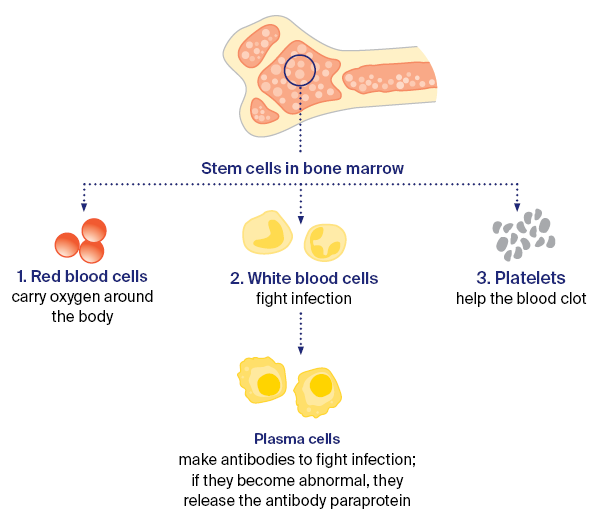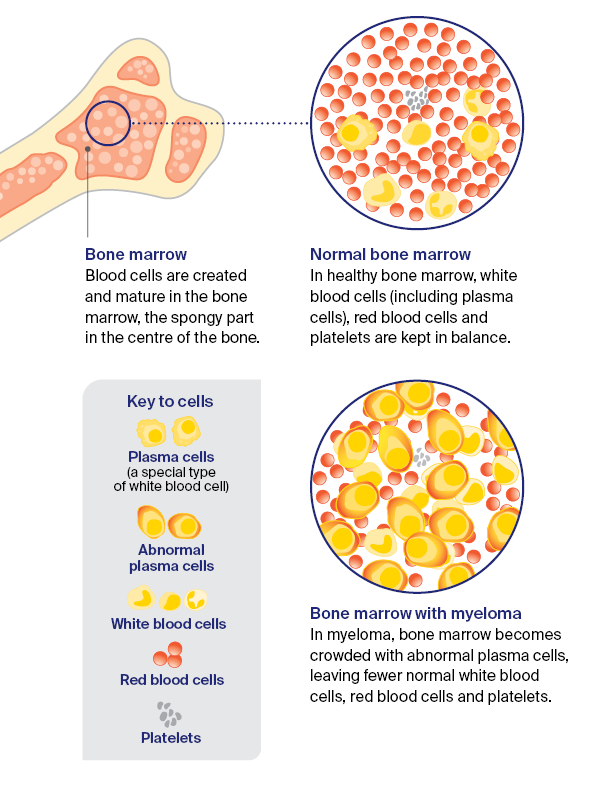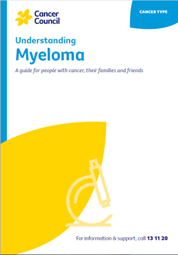About myeloma
Myeloma is blood cancer of the plasma cells that are made in the bone marrow. Because bone marrow is found throughout the body, myeloma can affect multiple areas at the same time, and the disease is often called multiple myeloma.
Learn more about:
- The blood
- What is blood cancer?
- What is myeloma?
- How myeloma starts
- How is it different from leukaemia?
- What causes myeloma?
- Who gets myeloma?
The blood
Blood is pumped around your body to provide oxygen and nutrients to your organs and tissues, and remove waste. It contains red blood cells, white blood cells and platelets – each with its own job to help the body function.
All three types of blood cells live for a limited time and need to be continually replaced. Most are made in the bone marrow – the spongy centre of the bones. The bone marrow contains stem cells. These are unspecialised blood cells that develop into mature red or white blood cells or platelets. Once mature, blood cells are usually released into the bloodstream to carry out their jobs.
What is blood cancer?
Cancer is a disease of the cells. Cells are the body’s basic building blocks – they make up tissues and organs. The body constantly makes new cells to help us grow, replace worn-out tissue and heal injuries.
Normally, cells multiply and die in an orderly way, so that each new cell replaces one lost. Sometimes cells become abnormal and keep growing. These abnormal cells may turn into cancer.
In solid cancers, such as breast cancer, the abnormal cells form a mass or lump called a tumour. However, myeloma is a blood cancer that starts in the bone marrow. Bone marrow is the spongy centre of the bone where blood cells are produced.
In myeloma, a type of white blood cell, called a plasma cell, changes and becomes abnormal. Healthy plasma cells make antibodies, called immunoglobulins, that protect us from infection.
Without treatment, the bone marrow keeps making more abnormal myeloma cells, leaving less room for normal healthy blood cells. This drop in healthy blood cells and antibodies weakens the immune system and can damage the kidneys. Myeloma can then spread to other parts of the body that contain bone marrow, such as the spine, skull, shoulders, ribs and pelvis.
Most myeloma cells produce an abnormal antibody called paraprotein, which enters the bloodstream. Levels of paraprotein usually build up in the blood, and may be detected on a blood test.
Stem cells

What is myeloma?
Myeloma begins when abnormal plasma cells, known as myeloma cells, start multiplying. Normal plasma cells make different types of antibodies to help the body fight infections. Abnormal plasma cells make an antibody known as paraprotein, M-protein or monoclonal protein. Paraprotein is found in the blood of most people who have myeloma.
Because the myeloma cells crowd out the bone marrow, there is less space for normal blood cells to develop and keep you healthy. As a result, a lack of:
- normal plasma cells and other white blood cells can make a person more likely to get infections
- red blood cells (anaemia) can cause fatigue
- platelets can cause bleeding and bruising.
How myeloma starts
Bone marrow produces three main types of blood cells: red cells, white cells and platelets.
Plasma cells are a special type of white blood cell. Myeloma starts when plasma cells become abnormal and multiply, crowding the bone marrow. They usually also release an antibody (paraprotein) into the blood.

How is it different from leukaemia?
Myeloma and leukaemia are both types of blood cancer, but they affect the body in different ways. Leukaemia is cancer of the white blood cells, which can be detected on a specific blood test.
Myeloma is cancer of the plasma cells, which are found in the bone marrow and not usually detected in the blood.
In rare cases, cancerous plasma cells form a tumour in the bone or tissue, called solitary or multiple solitary plasmacytoma. Unlike myeloma, solitary plasmacytoma produces few or no abnormal plasma cells in the bone marrow. Because it is located in one area, plasmacytoma is usually treated with radiation therapy. Some people may later develop myeloma or another plasmacytoma.
What causes myeloma?
Myeloma is not inherited and does not run in families. The exact cause of myeloma is still relatively unknown. Plasma cells become cancerous (myeloma) when there are certain DNA changes. DNA is found in all cells and carries instructions that control how cells work. It isn’t always clear what causes DNA changes.
Most cases of myeloma have no known cause, but things linked to an increased risk include:
- exposure to certain toxic chemicals, including dioxins used in industry, benzenes, and some chemical herbicides
- being near high levels of radiation
- certain viruses (such as HIV)
- having monoclonal gammopathy of undetermined significance (MGUS).
Who gets myeloma?
In Australia, about 2600 Australians are diagnosed with myeloma each year. Myeloma accounts for about 13% of blood cancers and about 1% of all cancers.
It is most common in people aged over 60. Myeloma can still affect younger people, but it is quite rare in people aged under 40. There are slightly more men diagnosed with myeloma than there are women.
More resources
Dr Ian Bilmon, Haematologist, Westmead Hospital and The Sydney Adventist Hospital; Martin Boling, Consumer; Catherine Bowley, Myeloma Support Nurse, Myeloma Australia; Dr Samuel Dickson, Radiation Oncologist, Calvary Mater Newcastle; Rachelle Frith, Clinical Nurse Consultant, Haematology, Prince of Wales Hospital; Dr Wojt Janowski, Haematologist, Calvary Mater Newcastle; Yvonne King, 13 11 20 Consultant, Cancer Council NSW.
View the Cancer Council NSW editorial policy.
View all publications or call 13 11 20 for free printed copies.
Need to talk?
Support services
Coping with cancer?
Speak to a health professional or to someone who has been there, or find a support group or forum
Looking for transport, accommodation or home help?
Practical advice and support during and after treatment
Cancer information
Blood cancers
Learn about the different blood cancers, such as leukaemia, lymphoma and myeloma
Dealing with the diagnosis
Common reactions to a cancer diagnosis and how to find hope
View our publications
Guides and fact sheets for people with cancer, their families and friends

